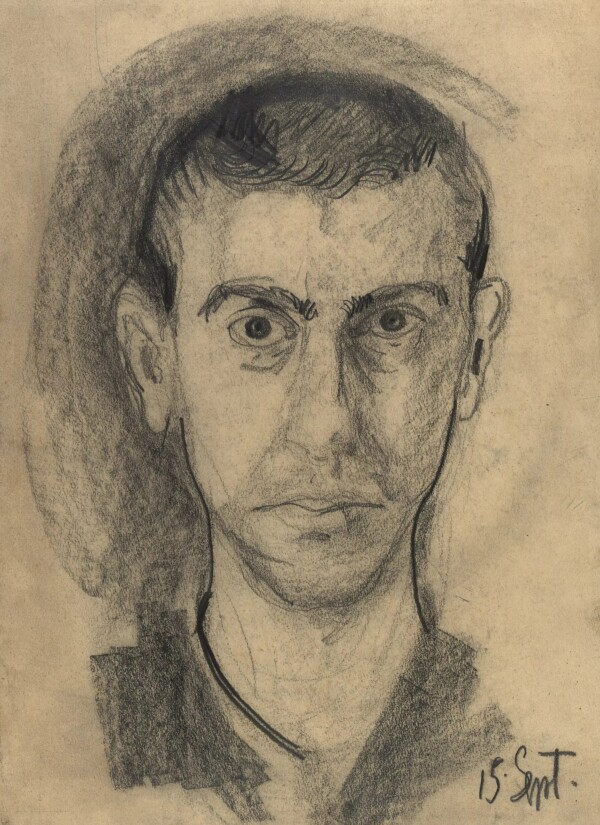Richard Gerstl

Richard Gerstl: Self-portrait, 1907
© Wien Museum
The painter Richard Gerstl, who committed suicide at a young age, was one of the pioneers of Expressionism. His artistic development was influenced by Vincent van Gogh, Edvard Munch, and, in particular, by the circle of musicians surrounding Arnold Schönberg, whereas Gerstl consciously distanced himself from Gustav Klimt’s art and aesthetics.
Gerstl’s Artistic Development
Richard Gerstl was born on 14 September 1883. He came from a wealthy Jewish family in Vienna, who later converted to Christianity. He could rely on financial support throughout his life.
After attending private painting schools, Gerstl began studying at the Vienna Academy of Fine Arts in 1898. He was taught by Christian Griepenkerl, one of the leading painters of the Ringstraße period. He was soon disillusioned with the conservatism of the Vienna Academy, however. Seeking new forms of artistic expression, Gerstl took lessons at Simon Hollósy’s painting school in Siebenbürgen (now Transylvania) in the summer months of 1900 and 1901 and suspended his studies at the Vienna Academy. Gerstl intensively explored the fields of contemporary literature, philosophy, psychology and music between 1902 and 1904, gaining insights that had a lasting influence on his oeuvre. He resumed his studies in 1906 in a specialist class taught by Heinrich Lefler, one of the founding members of the Hagenbund.
Rejection of Jugendstil
Gerstl’s idols included Vincent van Gogh and Edvard Munch, whose works he saw at exhibitions of the Vienna Secession. The Miethke Gallery also held an extensive solo exhibition of van Gogh in 1906, showing 45 works that inspired not only Gerstl but also Gustav Klimt. Gerstl sought to distance himself from the achievements and forms of expression of his fellow Austrian artists. In 1907, Gerstl even declined an invitation by the Miethke Gallery to participate in an exhibition that also presented works by Klimt. Unlike Schiele and Kokoschka, whose works also betrayed Expressionist tendencies and who took a lively interest in Klimt’s oeuvre and the art of Viennese Modernism, the young painter took a diametrically opposed, dismissive stance towards these artistic styles from the very beginning.
Gerstl participated in an exhibition of student works at the Vienna Academy the same year. In its review, the Wiener Zeitung praised him as “a promising talent.” This should remain the only public recognition he received during his lifetime. He did not participate in the Academy’s exhibition the following year. Irreconcilable artistic differences and a letter of complaint written by Gerstl to the Ministry of Culture and Education had resulted in his final expulsion.
Richard Gerstl and Schönberg’s Social Circle
Gerstl began socializing with Arnold Schönberg and his acquaintances, including Alexander Zemlinsky, David Josef Bach and Alban Berg, in 1906. He gave painting lessons to Schönberg and admired the composer’s artistic development towards atonality. Both were comparatively isolated in their positions as reformers in Vienna. Gerstl portrayed Schönberg’s artist friends and spent the summer months of 1907/08 with the Schönbergs in the lakeside town of Gmunden on the Traunsee. There, he began an affair with Schönberg’s wife Mathilde, which the composer eventually discovered. The resulting break with Schönberg increased Gerstl’s isolation and caused an identity crisis. Nevertheless, the artist created several haunting Expressionist self-portraits during this time, such as Self-Portrait, Laughing (1908, Belvedere, Vienna). In November of the same year, while the art of Viennese Modernism with Klimt at its center culminated in the “Kunstschau Wien,” Gerstl tragically took his own life, after destroying several of his works and written documents. Gerstl was laid to rest in an Ehrengrab [grave of honor] at the cemetery of Sievering in Vienna’s 19th District.
Gerstl established his position as one of Austria’s first Expressionists, even before Schiele and Kokoschka, with his conscious refusal and negation of the prevalent artistic formulations of his time, his preference for wild, gestic brushwork and his bold use of distortion, especially in his portraits. As a result, the artist was posthumously compared to Vincent van Gogh. It was decades after Gerstl’s death that his oeuvre finally received public recognition and appreciation, largely thanks to research published by Otto Kallir-Nirenstein and Rudolf Leopold.
Literature and sources
- Alexandra Matzner: Richard Gerstl, in: Meisterwerke Leopold Museum, Vienna 2018, S. 170-183.
- Klaus Albrecht Schröder: Richard Gerstl. 1883 – 1908. Dissertation, Vienna 1993.
- Raymond Coffer, Jill Lloyd, Ingrid Pfeiffer (Hg.): Richard Gerstl. Retrospektive, Munich 2017.
- Ekkehard Tanner: Schirn Magazin. Richard Gerstl gegen die Akademie. www.schirn.de/magazin/kontext/richard_gerstl/richard_gerstl_akademie_bildende_kuenste_wien/ (07/19/2022).
- Wiener Abendpost. Beilage zur Wiener Zeitung, 09.07.1907, S. 5.
- Werner Hofmann (Hg.): Experiment Weltuntergang – Wien um 1900, Ausst.-Kat., Hamburg Art Gallery (Hamburg), 10.04.1981–31.05.1981, Munich 1981, S. 211-213.
- Matthias Haldemann, Hans-Peter Wipplinger (Hg.): Richard Gerstl. Inspiration – Vermächtnis, Ausst.-Kat., Leopold Museum (Vienna), 27.09.2019–20.01.2020, Cologne 2019.

